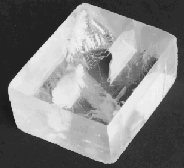|
The
Garibaldi Mine
Tabulam, New South
Wales |
|
By Tony Forsyth
If only one could travel back in time - to collect
specimens or visit places in hindsight! The following extracts, taken from separate
publications, give you some idea of the mineral riches that previously existed. They both
concern the same locality - the "Garibaldi Gold Mine" or "Garibaldi Crystal
Mine" as it is also sometimes known. The mine was situated near to the now deserted
gold-mining towns of Solferino and Lionsville. This site is not far from the present day
town of Tabulam, in North-Eastern NSW.
| Rich alluvial diggings gave way
to deep mining on the field, as the miners followed the gold- bearing reefs underground.
In c.1912, when diggers were trying to sink a shaft to cut the Garibaldi reef, the ground
sounded hollow when struck with their picks. It was decided to put in a shot of
explosives. When the dust had cleared, they saw that they had broken into a fairyland - a
crystal cave lined with calcite crystal. Tourists came from as far as Grafton to gaze on
this spectacle. It must have still been a sight years later, in the early 1920's, when
George Smith, Inspector of Mines for NSW wrote this report for the NSW Department of
Mines: |

Cleavage fragment of calcite
from the Garibaldi mine - 7cm x 7cm |
"A very interesting occurrence of this mineral
(calcite) may be seen in a large vugh in the Garibaldi Mine (Lionsville). It was
interesected obliquely at one end by a tunnel... As exposed, its largest dimensions are 70
ft. by 16 ft. and 9 ft. high. It is lined with crystals of calcite of all sizes up to 2
ft. or more in diameter, some are cloudy, but most are transparent of light sherry colour,
or colourless, and fine examples may be obtained of the variety which shows double
refraction clearly and is known as Iceland Spar. Further exploration might show that the
cavern extends beyond its known limits, but nothing has been done to enlarge it, and it
remains as when first discovered. Though many of the crystals have been broken and
removed, there yet remain so many intact that the damage is hardly noticeable...... Liquid
inclusions from small to large bubbles as much as 2 inches long were seen containing
possibly a desert-spoon full of the liquid..... upon some of the large crystals, short
stout, hexagonal prisms of secondary calcite have been deposited. As single crystals and
groups they are attached to the polished surfaces of the large crystals, and a very slight
jar will detach them from their smooth base."
It was not to be for long, as a passage from the book
Forgotten Country - The story of the Upper Clarence Gold Fields, by Isabel Wilkinson
records.
"There arrived in Lionsville c. 1924, a German,
Dr. Stroebal, and soon a new sensation stirred the district. The crystal was to be sent to
Germany for the manufacture of "high quality lenses". Machinery was brought and
set up to extract the crystal and a case mill, powered by an early model Fordson tractor
to cut timber for packing the precious glass-like blocks.... Many of the locals had jobs
in the new industry - taking out the blocks of crystal; cutting timber for the mill,
making the cases for packing; carting the finished crates of crystal to Grafton for
loading on to boats......Dr Stroebal gave instructions... none were to be broken, and as
each piece came out, a crate must be tailored to fit it.....It has been said that Dr
Stroebal travelled to Grafton each time a consignment went out and personally saw it
shippedsafely away to Germany...."
What a shame! Imagine the tourist drawcard that such a
place would make today! It is ironic that this "Iceland Spar" calcite was
probably sought for rangefinder devices that eventually were to be used as weapons of war
in the coming decade.
Bibliography:
- A Contribution to the Mineralogy of
New South Wales, George Smith
Mineral Resources Publication No. 34, 1926 pp 96
- Forgotten Country, Isabel Wilkinson 1980,
ISBN 0 9593763 0 5, pp 227
 News and Articles Index News and Articles Index
 Home Page Home Page
|
